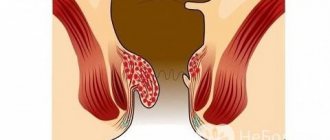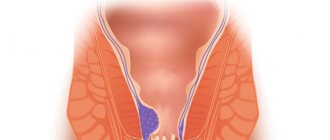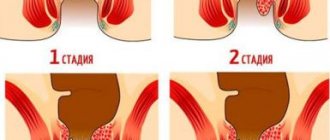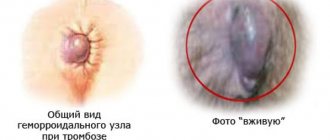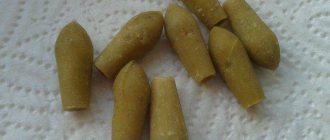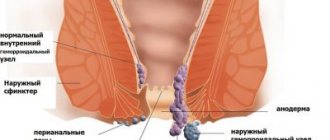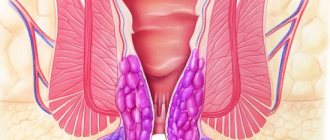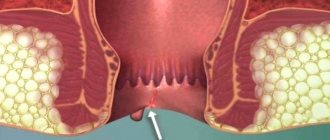Combined hemorrhoids are a subtype of inflammation of the hemorrhoidal veins, which differs from other forms of the disease in the localization of the inflamed nodes. In the external form of the disease, they are located outside the anus; in the internal form, they are located on the mucous membranes of the lower rectum. With a mixed type of disease, inflamed hemorrhoidal veins are located both outside and inside the anal canal. The disease is characterized by an imperceptible onset and sudden exacerbations, accompanied by severe pain during bowel movements and anal bleeding.
With mixed type of hemorrhoids, inflamed hemorrhoidal veins are located both outside and inside the anal canal.
Causes
Combined type hemorrhoids most often develop with a combination of the following unfavorable factors:
- Impaired intestinal motility (frequent constipation).
- Physical inactivity and a sedentary lifestyle contribute to blood stagnation in the pelvic area.
- Excess weight, leading to compression of hemorrhoidal veins.
- Constant intense physical activity.
- Impaired blood circulation.
- Insufficient liver functionality.
- Infectious diseases.
The risk group includes pregnant women, as well as people who, due to their occupation, are forced to sit for long periods of time or lift heavy weights, have unhealthy eating habits and systematically abuse alcohol.
Physical inactivity and a sedentary lifestyle contribute to blood stagnation in the pelvic area.
Also, some doctors tend to regard specific sexual preferences as a risk factor, justifying their opinion by the fact that with regular anal sex, the sphincter is stretched and hemorrhoidal veins are not held by muscles that have lost their tone.
Possible complications
Combined hemorrhoids of 2 and 3 degrees are an unpleasant disease, which is accompanied by the development of unpleasant symptoms and causes a lot of inconvenience. The patient suffers from constant pain and the following complications may develop:
- Anemia. The main reason for the development of this pathology is frequent bleeding from hemorrhoidal cones. The patient is bothered by frequent dizziness and constant weakness.
- Thrombosis of hemorrhoidal cones. With this pathological condition, inflammation of the veins is observed, and they swell greatly, which causes pain. In complicated situations, hemorrhoidal cones turn bluish and tissue necrosis is possible.
- Paraproctitis. With this infectious disease, numerous cracks form in the anal area. If hygiene rules are not followed, infections enter the wounds, which provokes an inflammatory process.
stage 2 combined hemorrhoids as early as possible and begin effective treatment, which will prevent the development of dangerous complications.
https://youtu.be/2iBv8D-Hgzw
Symptoms and stages of hemorrhoids
For a coloproctologist, who is faced with the task of curing hemorrhoids of the combined type, it is important to determine the extent of this disease, since treatment methods effective for relieving inflammation at different stages differ significantly.
Primary diagnosis is carried out according to the symptom complex characteristic of each stage of development of this disease.
Stage 1
In the first period, hemorrhoids are almost asymptomatic. The nodes are not identified during examination, and only with a digital examination can minor compactions be detected inside and outside the anal canal. The development of the disease is indicated by moderate anal itching and mucous discharge from the anal canal. After defecation, there may be a feeling of incomplete bowel emptying and the presence of a foreign body in the intestinal lumen.
The primary diagnosis of combined hemorrhoids is carried out according to the symptom complex characteristic of each stage of development of this disease.
2 stages
Noticeable discomfort appears with stage 2 hemorrhoids of the combined type. It most often occurs during or after a bowel movement. After defecation, internal nodes that come out are felt in the anal area, which after some time spontaneously reduce. Due to internal micro-tears, a few drops of blood may come out.
3 stages
A characteristic sign of grade 3 hemorrhoids is the release of inflamed internal nodes and an increase in the size of external hemorrhoids.
Due to excessive filling with blood, the nodes begin to bleed - both during bowel movements and outside of bowel movements.
Hemorrhoidal cones cannot be reduced, causing pain and discomfort when walking and standing in an upright position.
4 stages
At the last stage, blood clots appear in the blood vessels of the inflamed nodes, and the inflammatory process is complicated by thrombosis. Intense bleeding that occurs during this period of disease development leads to an anemic state, and the patient experiences constant weakness from blood loss. The act of defecation is accompanied by severe pain, fecal incontinence and flatulence develop.
Symptoms of combined hemorrhoids
Typically, a person begins to think about the presence of a problem when hemorrhoids bleed and traces of blood remain on the toilet paper. This occurs due to injury to the nodes by passing solid feces. They often complain of itching, irritation and burning. If treatment is not started at this stage, the disease worsens, hemorrhoids fall out during bowel movements and cause quite severe pain. In the early stages, the fallen bumps return to their place on their own, after a while they have to be set with your fingers, and then there comes a moment when it is impossible to set them even by hand.
Diagnostics
Mixed hemorrhoids are diagnosed during examination combined with digital examination. As part of the differential diagnosis and clarification of the volume of internal inflammation, additional laboratory and instrumental studies may be prescribed:
- A general blood test will determine the ESR, the content of leukocytes, erythrocytes, and hemoglobin.
- Coprogram – carried out to identify blood impurities in stool.
- Anoscopy is a test that will reveal anal fissures or tumors.
- Sigmoidoscopy is a diagnostic technique that is more informative than examination using an anoscope, allowing to identify deep-seated focal inflammations.
As part of the differential diagnosis and clarification of the volume of internal inflammation, a general blood test may be prescribed.
Treatment of mixed hemorrhoids
Therapeutic courses are developed by proctologists based on data obtained during a preliminary examination, taking into account:
- degree of hemorrhoids;
- age and immune status of the patient;
- the actual state of the mucous membranes of the lower intestine;
- condition of the sphincter muscle tissue;
- general anamnesis.
The initial stages of combined type hemorrhoids can be treated conservatively; in the presence of multiple external and internal hemorrhoids, operations of varying degrees of invasiveness are recommended. Regardless of what methods are used to treat hemorrhoids - conservative or surgical - the course is carried out against the background of a gentle diet, which is recommended to be followed even after achieving stable remission of the disease.
Sclerotherapy is one of the minimally invasive methods for treating small hemorrhoids.
Minimally invasive therapy
Minimally invasive procedures are recommended for small hemorrhoids if conservative therapy methods have failed to achieve regression of chronic combined type hemorrhoids. Non-surgical methods for treating hemorrhoids include:
- sclerotherapy;
- coagulation (laser, infrared);
- ligation (suture, latex rings);
- cryotherapy.
In 80% of cases, the mixed form of hemorrhoids is completely eliminated using minimally invasive therapy methods.
Medication
Treatment with drugs intended for internal use and local therapy using suppositories, ointments and applications with analgesic and anti-inflammatory effects are highly effective only in the early stages of hemorrhoids. Drug therapy aimed at relieving symptoms is not able to help with advanced forms of the disease and is prescribed as an addition to minimally invasive therapeutic methods or radical surgery.
Surgical
Radical surgical intervention with simultaneous excision of hemorrhoids located inside and outside the anal canal is indicated for hemorrhoids of 3-4 degrees with the addition of acute thrombosis and heavy bleeding, opening even at rest. This is the only treatment method that is effective for multiple internal inflamed nodes that are constantly located outside the rectum.
Traditional treatment
Folk remedies in the treatment of hemorrhoids are used only as auxiliary methods of therapy.
Suppositories made from natural ingredients, herbal ointments and baths will help alleviate the condition of acute combined type hemorrhoids.
However, to cure this disease, you need to use home procedures in combination with other therapeutic methods, after consulting with your doctor about the advisability of their use.
https://youtu.be/DC1X1kULa9w
Types of pathology
Chronic hemorrhoids can occur in the following forms:
- outer
- interior
- combined.
Internal hemorrhoids are characterized by the fact that they develop inside the anus. Such a pathological condition may be a harbinger of an external disease. With severe inflammation of the intestines, hemorrhoids can be injured, and this results in bleeding. With internal hemorrhoids, severe pain appears, the localization of which becomes the internal area of the rectum. Treatment of this chronic form of the disease is usually carried out with the use of ointments, suppositories and lotions, which have an anti-inflammatory and hemostatic effect.
With chronic external hemorrhoids, the appearance of nodes in the anal area is observed, which can be easily identified by visual examination. When the pathology enters the acute stage, severe pain and bleeding develop. To eliminate such a chronic disease, combined treatment and surgery are widely used.
Combined hemorrhoids can occur unnoticed in a patient, and a person most often turns to a specialist for help when the disease has become chronic. With this pathology, symptoms of external and internal hemorrhoids, characteristic of chronic and acute forms, may simultaneously appear.
It is important to establish at what stage mixed hemorrhoids are, because the choice of one or another treatment method will depend on this in the future
Prevention of mixed hemorrhoids
In order to prevent the development of hemorrhoids, doctors recommend:
- adhere to a balanced diet, excluding from daily consumption foods that lead to constipation;
- adjust your lifestyle, do preventive exercises;
- consult a doctor promptly when the first signs of infection appear;
- Avoid physical activity involving heavy lifting.
First of all, people who have a genetic predisposition to the development of this disease and a history of varicose veins should listen to the recommendations of doctors.
